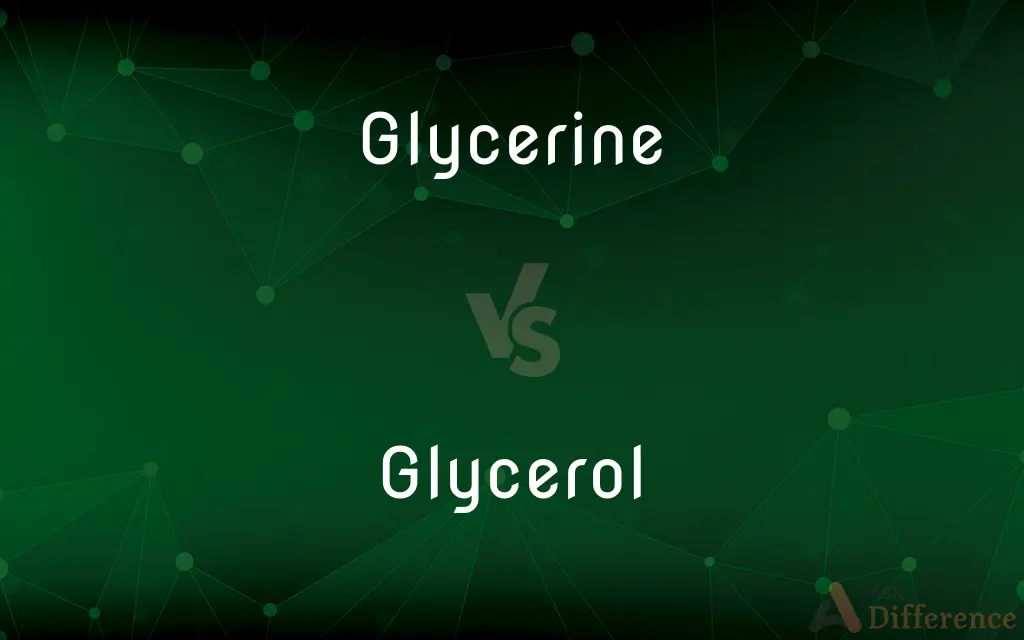Glycerine vs. Glycerol — What's the Difference?
Edited by Tayyaba Rehman — By Fiza Rafique — Updated on September 26, 2023
"Glycerine" and "glycerol" are often used interchangeably, but "glycerine" typically refers to the commercial or common name for the substance, while "glycerol" is the chemical or scientific name.

Difference Between Glycerine and Glycerol
Table of Contents
ADVERTISEMENT
Key Differences
Glycerine: Commonly found in skincare and cosmetic products as a moisturizing agent. Example: "This lotion contains glycerine for skin hydration." Glycerol: Used in scientific research to study its properties or in chemical formulations. Example: "The experiment required the use of pure glycerol."
Glycerine: Often found in consumer goods and household products. Example: "Glycerine is listed as an ingredient in this shampoo." Glycerol: Typically used in laboratory settings or when discussing chemical reactions. Example: "The reaction involved the addition of glycerol to the mixture."
Comparison Chart
Common vs. Scientific Name
Common name for glycerol
Scientific or chemical name for the compound
Everyday Usage
Used in consumer products and labeling
Predominantly found in scientific contexts
Product Labeling
Appears on skincare, food labels, etc.
Rarely used on consumer product labels
ADVERTISEMENT
Application
Versatile in commercial and household products
Commonly used in scientific research
Food Industry
Used as a sweetener in some food items
Rarely mentioned in food product labels
Compare with Definitions
Glycerine
It's found in consumer goods for its moisturizing properties.
Glycerine is an ingredient in this hand cream.
Glycerol
"Glycerol" is the scientific name for glycerine, commonly used in research.
The study examined the properties of glycerol.
Glycerine
Glycerine may also serve as a sweetener in certain food products.
This candy is made with glycerine for sweetness.
Glycerol
In chemistry, glycerol is recognized for its unique properties.
The reaction involved the addition of glycerol.
Glycerine
Glycerine is known for its wide range of commercial applications.
Many cosmetics use glycerine as a key ingredient.
Glycerol
It's primarily found in scientific and chemical contexts.
Glycerol is a key component in biochemistry.
Glycerine
"Glycerine" is the common name for glycerol, often used in skincare products.
This soap contains glycerine for soft skin.
Glycerol
Glycerol is used in laboratory settings for various experiments.
The experiment required the use of pure glycerol.
Glycerine
In everyday usage, it's the term you'll see on product labels.
Check the glycerine content in this lotion.
Glycerol
Scientific literature often employs the term "glycerol" for precision.
The formula includes glycerol as a solvent.
Glycerine
Glycerol or a preparation of glycerol.
Glycerol
Glycerol (; also called glycerine in British English or glycerin in American English) is a simple polyol compound. It is a colorless, odorless, viscous liquid that is sweet-tasting and non-toxic.
Glycerine
(organic compound) The common name for glycerol, glycerin or E422.
Glycerol
A colourless, sweet, viscous liquid formed as a by-product in soap manufacture. It is used as an emollient and laxative, and for making explosives and antifreeze.
Glycerine
A sweet syrupy trihydroxy alcohol obtained by saponification of fats and oils
Glycerol
A syrupy, sweet, colorless or yellowish liquid triol, C3H8O3, obtained from fats and oils as a byproduct of saponification and used as a solvent, antifreeze, plasticizer, and sweetener and in the manufacture of dynamite, cosmetics, liquid soaps, inks, and lubricants.
Glycerol
(organic compound) 1,2,3-trihydroxy-propane or propan-1,2,3-triol; a trihydric alcohol
Glycerol
A syrupy sweet liquid obtained as a by-product in the manufacture of soap from animal or vegetable oils and fats; it is used as an antifreeze, a plasticizer, and a food sweetener and in the manufacture of dynamite, cosmetics etc.
Glycerol
Same as Glycerin.
Glycerol
A sweet syrupy trihydroxy alcohol obtained by saponification of fats and oils
Common Curiosities
What is glycerine?
Glycerine is a common name for glycerol, commonly used in skincare and consumer products.
Where is glycerine commonly found?
It appears in skincare products, soaps, and is used as a sweetener in some foods.
Can glycerine be used as a food additive?
Yes, glycerine is used as a sweetener in some food items.
Is glycerine the same as glycerol?
Yes, glycerine is the common name for the chemical compound glycerol.
How is glycerine used in skincare?
Glycerine is known for its moisturizing properties and is used in lotions and creams.
Where is glycerol primarily used?
Glycerol is mainly used in scientific research, chemistry, and biology.
What is glycerol?
Glycerol is the scientific and chemical name for glycerine.
Is glycerol different from glycerine?
No, glycerol and glycerine refer to the same chemical compound.
How is glycerol used in laboratory settings?
Glycerol is used in experiments, particularly in biochemistry and chemical reactions.
Is glycerol mentioned on consumer product labels?
Glycerol is rarely mentioned on consumer product labels; "glycerine" is more common.
Share Your Discovery

Previous Comparison
Ascot vs. Scarf
Next Comparison
Telecommunication vs. CommunicationAuthor Spotlight
Written by
Fiza RafiqueFiza Rafique is a skilled content writer at AskDifference.com, where she meticulously refines and enhances written pieces. Drawing from her vast editorial expertise, Fiza ensures clarity, accuracy, and precision in every article. Passionate about language, she continually seeks to elevate the quality of content for readers worldwide.
Edited by
Tayyaba RehmanTayyaba Rehman is a distinguished writer, currently serving as a primary contributor to askdifference.com. As a researcher in semantics and etymology, Tayyaba's passion for the complexity of languages and their distinctions has found a perfect home on the platform. Tayyaba delves into the intricacies of language, distinguishing between commonly confused words and phrases, thereby providing clarity for readers worldwide.
















































